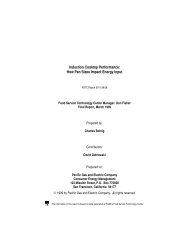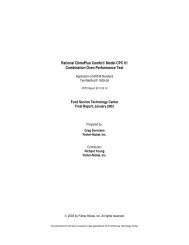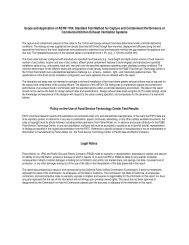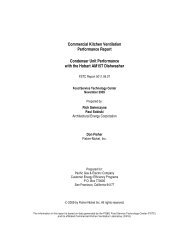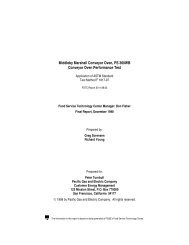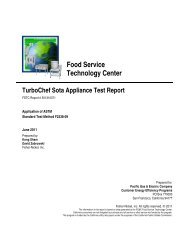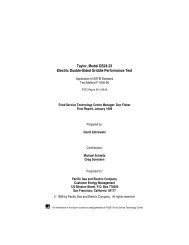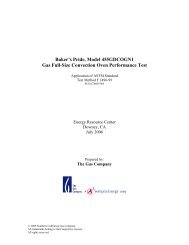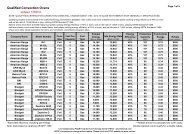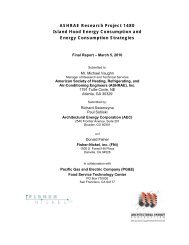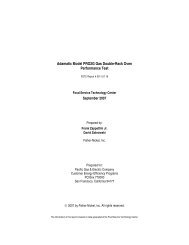Grease Filter Efficiency Test Method - Food Service Technology ...
Grease Filter Efficiency Test Method - Food Service Technology ...
Grease Filter Efficiency Test Method - Food Service Technology ...
You also want an ePaper? Increase the reach of your titles
YUMPU automatically turns print PDFs into web optimized ePapers that Google loves.
To determine particle collection efficiency, the large particle aerosol generator outlet was<br />
placed on the center of the griddle and 11 in. above the griddle (with the griddle off or on)<br />
without a filter in the hood. The OPC was used to determine the particle concentration as a<br />
function of size of the effluent for a two minute sample period. The filter was then installed<br />
and then the OPC sampled for another two minute sample period to determine the<br />
downstream concentration. The collection efficiency for each particle size range is defined in<br />
Equation 1.<br />
This procedure was repeated to determine the average collection efficiency and uncertainty in<br />
collection efficiency. The test protocol is given in Appendix E and the data analysis method<br />
is given in Appendix G.<br />
4. RESULTS<br />
4.1 CHARACTERIZATION<br />
4.1.1 Calibration of Griddle<br />
The results of the griddle calibration are given in Table 4.1. The average temperature<br />
measured for each location was found to be 375 ±5 ºF and was, therefore, within the<br />
specification of the ASTM Standard F 1275-99 [3].<br />
TABLE 4.1. GRIDDLE TEMPERATURES (ºF) FROM LEFT TO RIGHT<br />
Location 1 Location 2 Location 3 Location 4 Location 5 Location 6<br />
376 378 380 379 380 380<br />
4.1.2 Calibration of <strong>Test</strong> Airflow Rate<br />
The velocity profiles in the duct and the total volumetric flow rate through the duct were<br />
obtained for a total of four flow conditions. Approximately 63 data points were taken at<br />
each condition. As shown in Figure 4.1, the velocity profiles were found to agree well with<br />
published results for fully developed turbulent flow [7]. The remaining velocity profiles are<br />
given in Appendix B. The results were also used to determine the total exhaust volumetric<br />
flow rate at each condition so that the fan-system curve could be determined (see Figure 4.2).<br />
For a fan frequency of 24.5 Hz, the centerline velocity was found to be 1381 fpm with a total<br />
volumetric flow rate of 1,000 CFM through the 12 in. round exhaust duct (Figure 4.3).<br />
To obtain the correct airflow rate (1,000 CFM) when the baffles or filters were installed, the<br />
hot-film anemometer was placed at the sampling location in the center of the duct and the fan<br />
speed was increased until a velocity of 1381 fpm was obtained. The electrical power<br />
frequency supplied to the fan when the baffles were used was found to be 28.0 Hz and that<br />
for the filters was found to be 38.2 Hz. In addition, the pressure drops across the baffles and<br />
filters were measured and found to be 0.10 in. H 2 0 and 0.41 in. H 2 0, respectively.<br />
4.1.3 Aerosol Spatial Uniformity <strong>Test</strong>s<br />
Before any spatial uniformity data were obtained, the aerosol concentration was measured at<br />
the centerline of the duct with the aerosol generator located in the center of the griddle for at<br />
least 30 minutes to check the stability of the aerosol generators. No discernable variation<br />
with time was measured with each aerosol generator when the fluid levels in the reservoirs<br />
were properly maintained (see Appendix C).<br />
13



